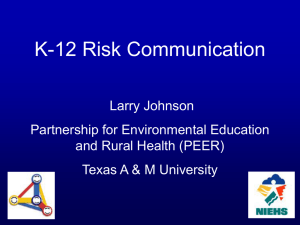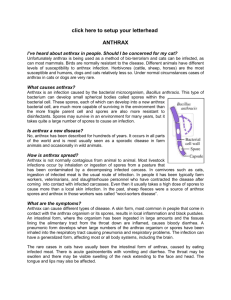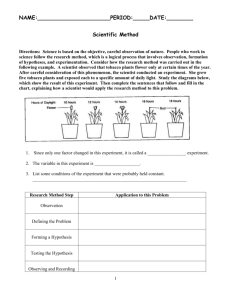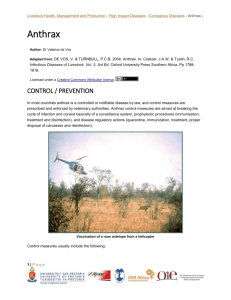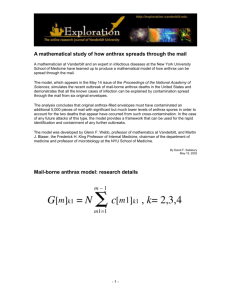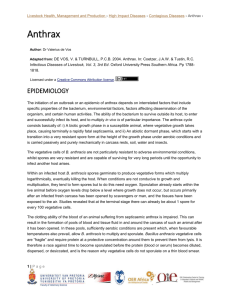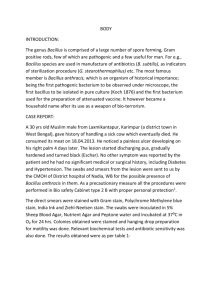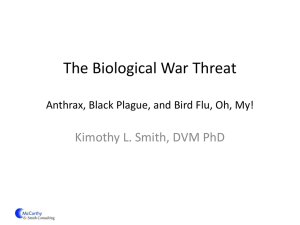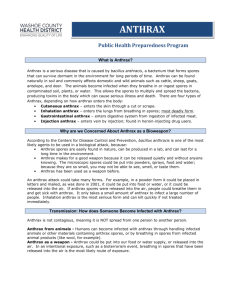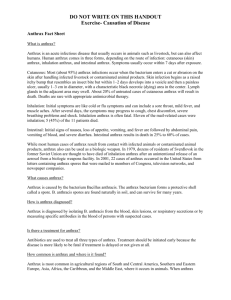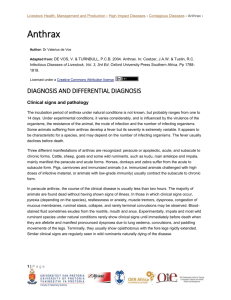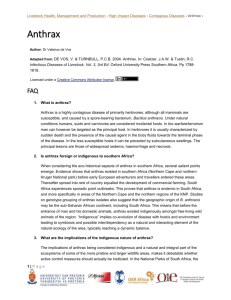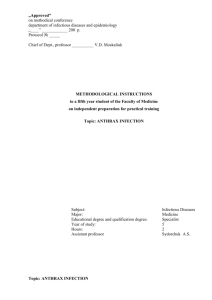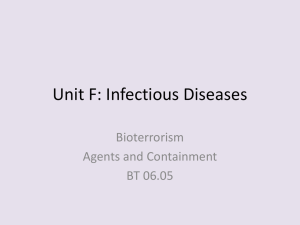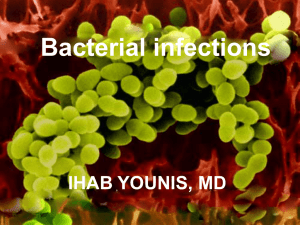Anthrax - Schools
advertisement
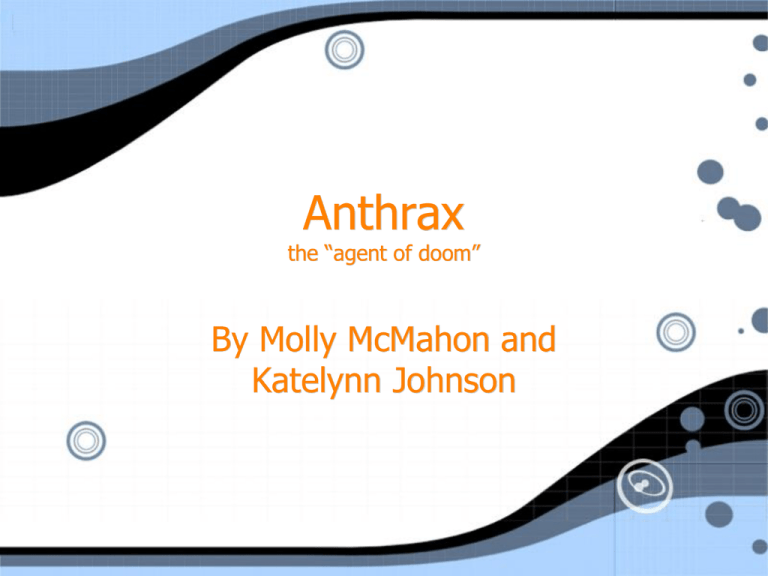
Anthrax the “agent of doom” By Molly McMahon and Katelynn Johnson Basic Info • Anthrax is an acute disease in animals caused by the bacteria Bacillus Anthracis. • Anthrax bacillus has the unique ability to form long-lived spores, they become inactive dormat spores and can remain this way for many decades maybe even centuries! This can be caused by: • The death of a host • Extremes in temperature Basic Info • Anthrax is found on all of the continents except Antarctica. • It most commonly infects wild and domesticate herbivorous mammals • Usually the mammals become infected by inhaling the bacteria while eating Infection • Ingestion is assumed to be the most common way animals are infected, however it is yet to be proven. • Carnivores are infected by feeding on infected animals. • Anthrax can infect humans by being exposed to infected blood or tissues, eat tissues of an infected organism, or are exposed to high densities of anthrax spores. Forms of Infection • • • • • Cutaneous anthrax Bacteria enters through cut or abrasion Contact with affected animals Easily treatable through antibiotics Symptoms: • Raised bump • Painless ulcer with a necrotic (cell death) center • Swollen lymph nodes locally Forms of Infection • • • • Gastointestinal Anthrax Infected meat is ingested Mortality rate 25-60% Symptoms • • • • • Loss of appetite Nausea Abdominal pain Vomiting of blood Severe diarrhea Forms of Infection • • • • Inhalation Anthrax Begins in lungs Incubation time of 7 days Mortality rate of 100% with 1-2 days of symptoms Symptoms: • • • • Unremarkable upper-respiratory infection Dyspnea (uncomftorable breathing) , diaphoresis (perspiring profusely), myalgia (muscle pain) Septic shock Infection • Anthrax does not spread directly from one infected organism to another, it’s the spores that are transferred from one organism to another. • There are 89 known strains of anthrax documented in the world today. • The most widely recognized is the Ames strain. It was the strain used in the 2001 Athrax attacks on the US. Infection • Once the spores are inhaled they are transported through the air passages of the body, and into the lungs. Macrophages pick up the spores and transport them to the lymph nodes. • Here the bacilli and spores cause damage to the lymph nodes and cause chest pain and difficulty breathing. • The spores germinate into active bacilli and burst the macrophages, multiplying and and infecting the body with more bacilli which are carried in the blood to the entire body. How anthrax infects Infection • To enter the cells the lethal factors use another protein produced by B. anthracis, protective antigen. Edema factor inactivates a type of phagocytic cell so that they lose the ability to phagocytose bacteria, meaning that it cannot destroy the matter Infection • Recent evidence indicates that anthrax targets endothelial cells and cause vascular leakage of fluid and cells in the body. This leads to hypovolemic shock which is basically low blood volume and septic shock. Infection Infection • The severity of a strain of Anthrax depends on many factors, however the poly-D-glutamic acid capsule that protects the bacterium from phagocytosis by the specific host cell and its toxins are a primary factor. Anthrax & Biological Warfare • The Ames strain was used in the 2001 Anthrax attacks on the US in a series of mailed letters. • The Vollum strain was isolated in 1935, developed as a biological weapon for WWII, it was never used. • The Vollum strain was also used during the Gruinard bioweapons trials. • The Vollum 1B strain was used during the 1960’s in US and UK bioweapon programs. Anthrax & Biological Warfare • 220 pounds of powdered anthrax material, seeded into the air of a city, could kill more than 1 million people. • In contrast, 80,000 would die in the explosion of a 12.5-kiloton atomic bomb. Why Anthrax? • It is easily grown • Easy to spread when spores are ‘healthy’ • High Mortality • Stores for long periods of time • Non-transmissible • Does not need ‘food’ to stay alive and reproduce Replication • Plasmid pXO1 is involved in the growth of B.anthracis • Anthrax spores enter the body through macrophages and are transported via the lymphatic system to the lymph nodes where germination occurs • As replication occurs the anthrax organisms release distinct toxins causing tissue edema, hemorrhage, and host cell death Factor proteins of Anthrax • Lethal Factor (LF): • Adheres to enzymes important to cell division • Stimulates macrophages and causes inflammation, which is normally a protective mechanism. But the LF enzyme is so active that the hormone and inflammation become lethal to the cells. • Edema Factor (EF): • Leads to water unbalance, diarrhea, pneumonia, swelling • This enzyme stimulates production of a normal cellular hormone, so much so that the hormone levels immobilize the cellular immune system. The cell becomes defenseless. • Protective Antigen (PA): • Promotes endocytosis (cell drinking) of itself • Escape route from the endosome Reproduction • Anthrax reproduces asexually • While this is not rare, the spores that anthrax produces are “super” • This means that the have an extremely thick outer wall which allows it to survive in many different kinds of environments More on factor proteins • Neither the Edema factor protein or the Lethal Factor protein can enter cells without Protective Antigen • Alone, the Protective Antigen is not harmful • The lysis of macrophages and other cells leads to release of: • Pro-inflammatory mediators • Reactive O2 and N2 species • Lysomal enzymes which can attempt to protect the cell • Anthrax proteins inhibit cell replication Treatment • The first effective vaccine that was developed for anthrax was developed in 1881 by French scientist Louis Pasteur. • Australia, New Zealand, Russia, Europe, North American and parts of Africa and Asia have all contributed to more than 100 years of animal vaccination programs. • These programs have made Anthax a very rare disease in animals with only a few dozen cases reported each year. Side Effects of Vaccine • 30% report minor reactions: soreness, redness, itching, swelling and lumps at the injection site • 35% experience muscle or joint aches, chills, fever, headaches, nausea, loss of appetite, feeling on unease • Serious reactions requiring hospitalization are rare, occurring about once per 50,000 doses. • Severe allergic reactions can occur after any vaccination less than one per 100,000 doses Antibiotics • Most antibiotics are effective against B.anthracis: • Doxycycline • Penicillin • Amoxicillin • If inhaled or ingested, medications through an IV reach the bacteria quickly • Treatment can last for up to 60 days


